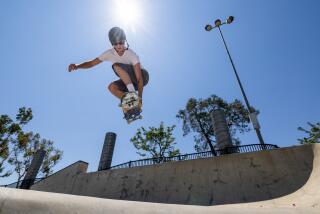Street Skating . . . in Graphic Detail
- Share via
Besides influencing fashion, street skating has had an effect on equipment.
Boards, or decks, are lighter, 1 to 2 inches longer and narrower (8 inches versus 10 inches); wheels are smaller and harder so skaters can maintain a lower center of gravity and roll through turns more quickly. Smaller wheels cut down on speed, but street skaters are more interested in maneuverability anyway.
Perhaps the most obvious difference between the old and new skateboards is the graphics. Images of heavy-metal bands and demonistic portraits have been replaced by environmental scenics, condoms, naked men and women, and scenes of mayhem. One popular graphic is called “accidental gun death” and features a teen-ager being shot while his parents look on in horror. Another depicts mass murderers--a big seller at Rat City in Burbank.
“I won’t sell graphics of naked women to kids under 18,” says store manager Max Hamilton. “But I do sell the mass murderers. There’s nothing graphically violent. They’re just pictures of people, and I don’t think most kids realize what they’re pictures of.”
The cost of these new boards adds greatly to the sport’s expense. Counterfit offers one of the best deals: a seven-ply maplewood board for around $35. Slick polyurethane boards, which usually offer more intricate graphics, cost upward of $70. But they don’t last long. What’s more, the wheels are sold separately.
Robbie Hall, a 14-year-old skater from North Hollywood, had his new $49 board less than an hour before its bottom was completely scuffed from riding down stairway handrails and sliding on street curbs. “This board will probably last me about two or three weeks,” he says.
Sales of skateboards reached about $9 million in 1992. Not surprisingly, that figure is expected to grow this year.


